Person-Centered Care and Integrated Working: A Detailed Analysis
VerifiedAdded on 2023/06/12
|9
|2835
|207
Essay
AI Summary
This essay delves into the principles of person-centered care and integrated working within healthcare, emphasizing their importance in patient well-being and treatment efficacy. It uses the case study of Fionn, a 30-year-old patient recovering from a motorcycle accident, to illustrate the application of supported self-care management and shared decision-making. The essay discusses the benefits of involving patients in their treatment plans, fostering transparency, and providing mental support. It also addresses potential limitations and challenges, such as communication barriers and conflicting decisions, while highlighting the role of legislative policies like the National Health Service Act 1948 and the Health and Social Care Act 2013 in supporting patient care. Furthermore, it examines theoretical frameworks like the health belief model and the theory of planned behavior to understand and improve patient engagement and adherence to treatment. The conclusion underscores the value of person-centered care in enhancing patient outcomes and promoting a collaborative healthcare environment.
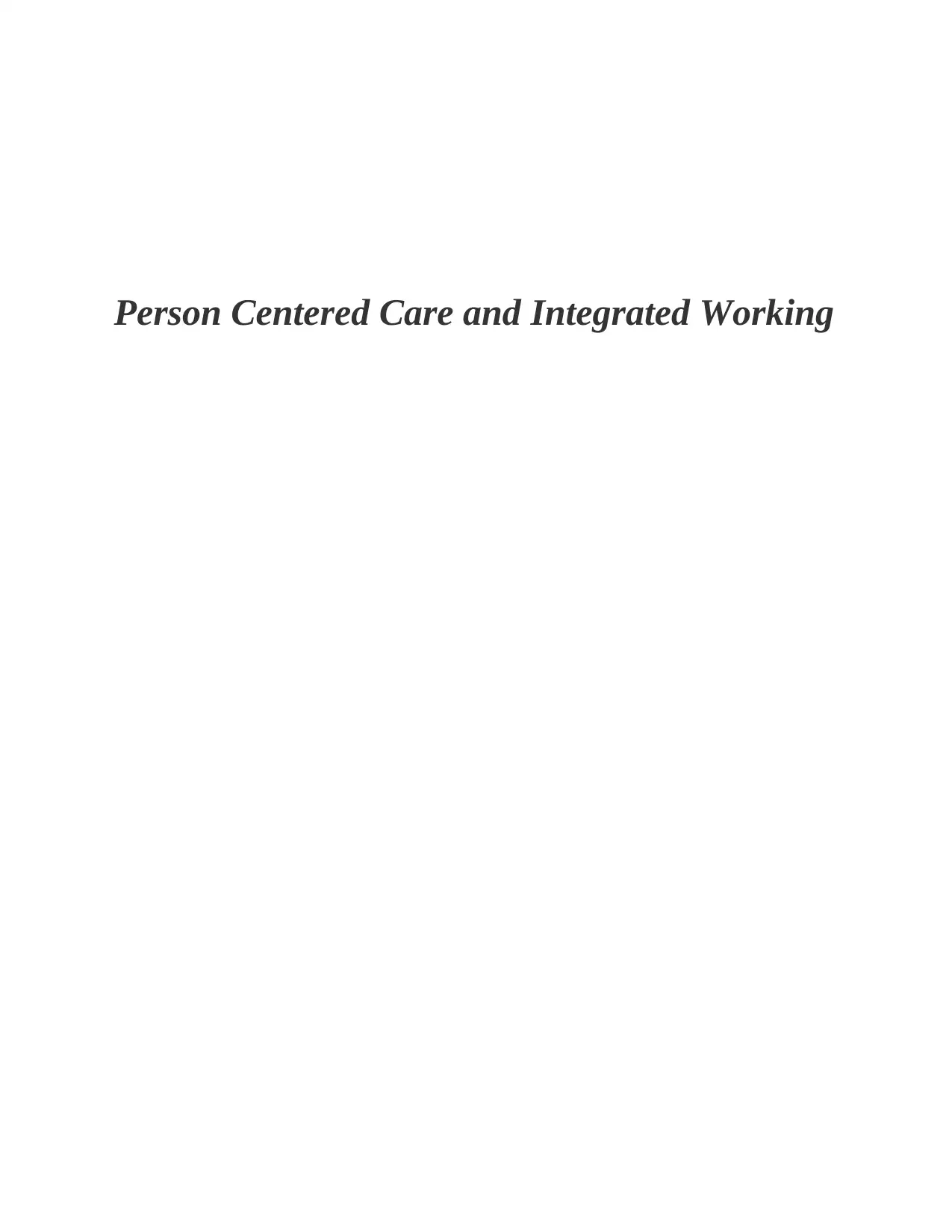
Person Centered Care and Integrated Working
Paraphrase This Document
Need a fresh take? Get an instant paraphrase of this document with our AI Paraphraser
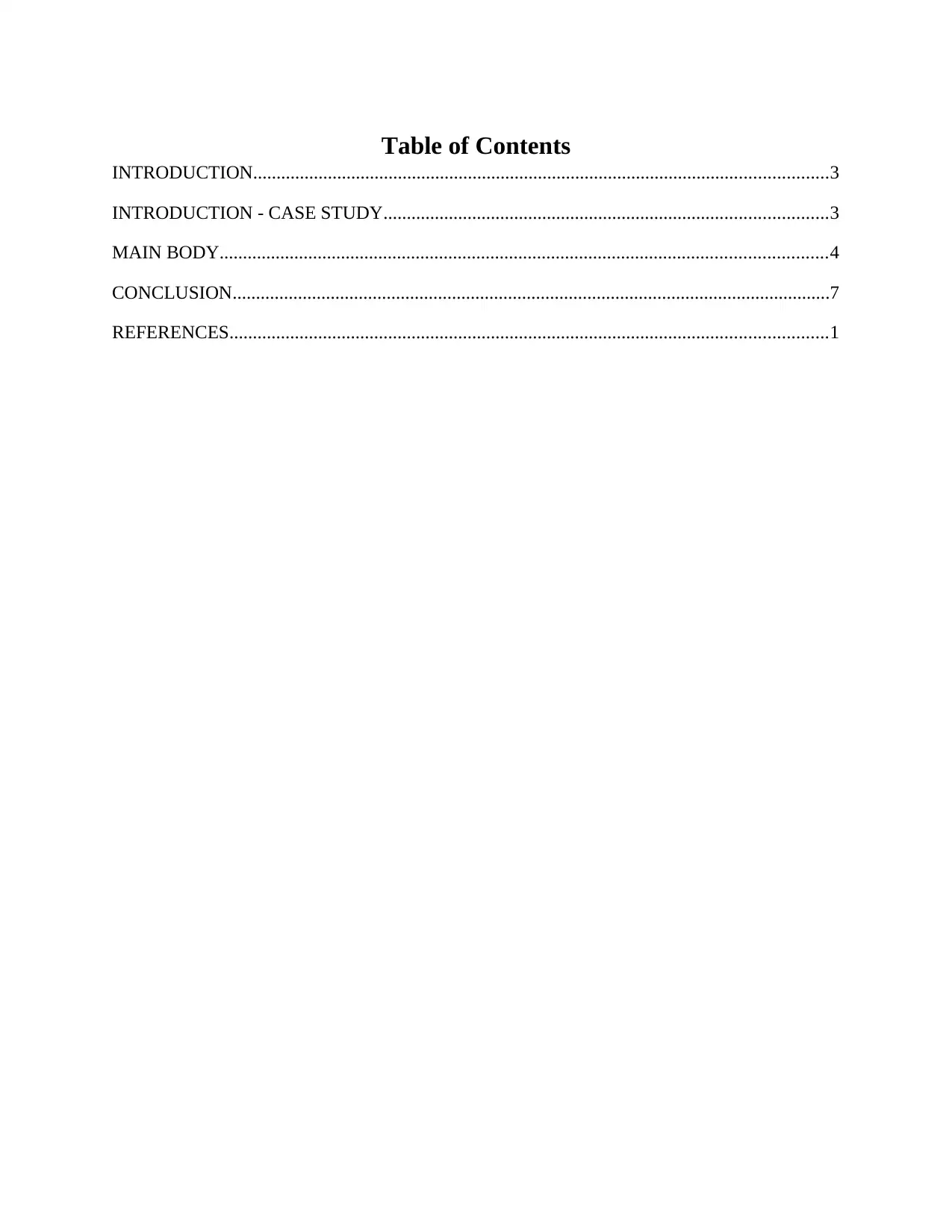
Table of Contents
INTRODUCTION...........................................................................................................................3
INTRODUCTION - CASE STUDY...............................................................................................3
MAIN BODY..................................................................................................................................4
CONCLUSION................................................................................................................................7
REFERENCES................................................................................................................................1
INTRODUCTION...........................................................................................................................3
INTRODUCTION - CASE STUDY...............................................................................................3
MAIN BODY..................................................................................................................................4
CONCLUSION................................................................................................................................7
REFERENCES................................................................................................................................1
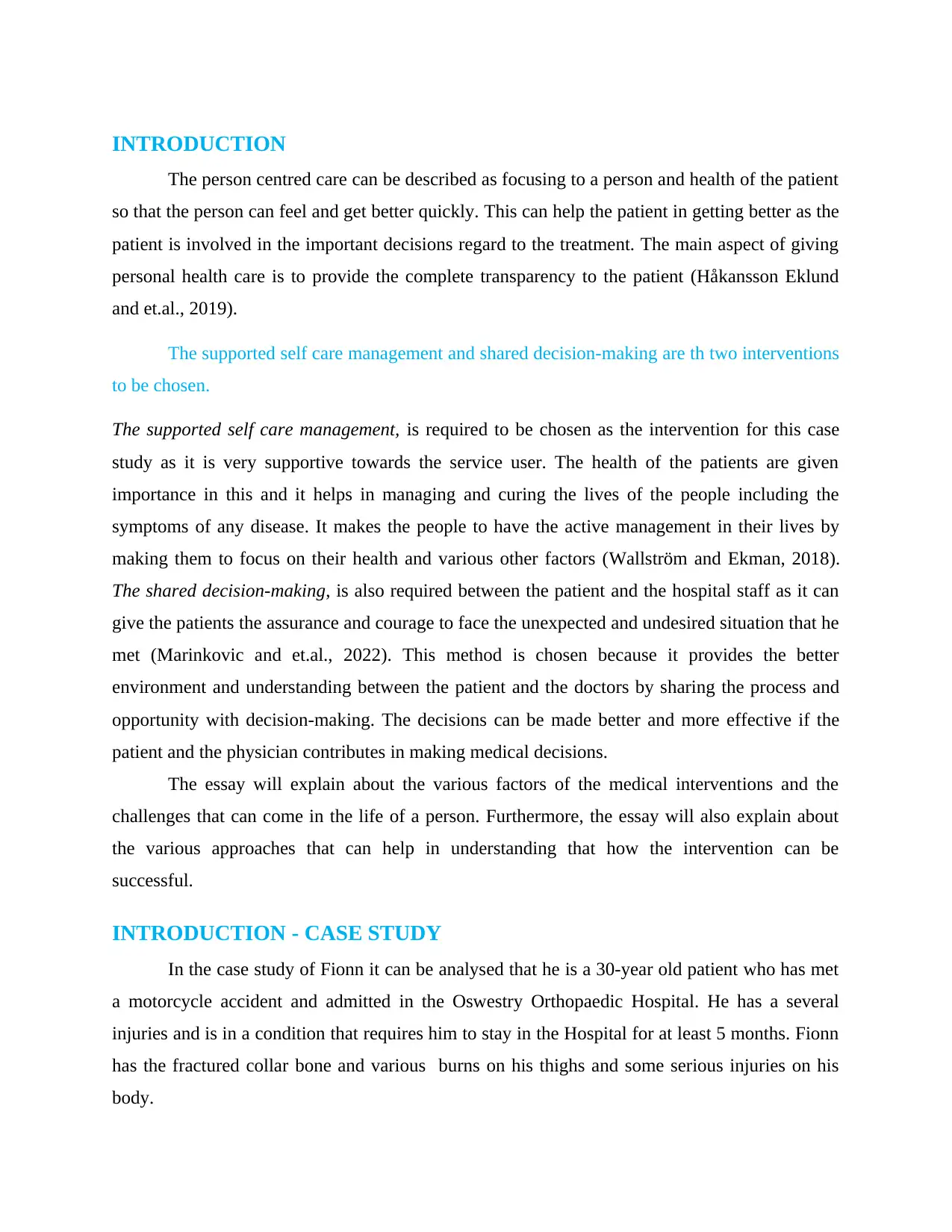
INTRODUCTION
The person centred care can be described as focusing to a person and health of the patient
so that the person can feel and get better quickly. This can help the patient in getting better as the
patient is involved in the important decisions regard to the treatment. The main aspect of giving
personal health care is to provide the complete transparency to the patient (Håkansson Eklund
and et.al., 2019).
The supported self care management and shared decision-making are th two interventions
to be chosen.
The supported self care management, is required to be chosen as the intervention for this case
study as it is very supportive towards the service user. The health of the patients are given
importance in this and it helps in managing and curing the lives of the people including the
symptoms of any disease. It makes the people to have the active management in their lives by
making them to focus on their health and various other factors (Wallström and Ekman, 2018).
The shared decision-making, is also required between the patient and the hospital staff as it can
give the patients the assurance and courage to face the unexpected and undesired situation that he
met (Marinkovic and et.al., 2022). This method is chosen because it provides the better
environment and understanding between the patient and the doctors by sharing the process and
opportunity with decision-making. The decisions can be made better and more effective if the
patient and the physician contributes in making medical decisions.
The essay will explain about the various factors of the medical interventions and the
challenges that can come in the life of a person. Furthermore, the essay will also explain about
the various approaches that can help in understanding that how the intervention can be
successful.
INTRODUCTION - CASE STUDY
In the case study of Fionn it can be analysed that he is a 30-year old patient who has met
a motorcycle accident and admitted in the Oswestry Orthopaedic Hospital. He has a several
injuries and is in a condition that requires him to stay in the Hospital for at least 5 months. Fionn
has the fractured collar bone and various burns on his thighs and some serious injuries on his
body.
The person centred care can be described as focusing to a person and health of the patient
so that the person can feel and get better quickly. This can help the patient in getting better as the
patient is involved in the important decisions regard to the treatment. The main aspect of giving
personal health care is to provide the complete transparency to the patient (Håkansson Eklund
and et.al., 2019).
The supported self care management and shared decision-making are th two interventions
to be chosen.
The supported self care management, is required to be chosen as the intervention for this case
study as it is very supportive towards the service user. The health of the patients are given
importance in this and it helps in managing and curing the lives of the people including the
symptoms of any disease. It makes the people to have the active management in their lives by
making them to focus on their health and various other factors (Wallström and Ekman, 2018).
The shared decision-making, is also required between the patient and the hospital staff as it can
give the patients the assurance and courage to face the unexpected and undesired situation that he
met (Marinkovic and et.al., 2022). This method is chosen because it provides the better
environment and understanding between the patient and the doctors by sharing the process and
opportunity with decision-making. The decisions can be made better and more effective if the
patient and the physician contributes in making medical decisions.
The essay will explain about the various factors of the medical interventions and the
challenges that can come in the life of a person. Furthermore, the essay will also explain about
the various approaches that can help in understanding that how the intervention can be
successful.
INTRODUCTION - CASE STUDY
In the case study of Fionn it can be analysed that he is a 30-year old patient who has met
a motorcycle accident and admitted in the Oswestry Orthopaedic Hospital. He has a several
injuries and is in a condition that requires him to stay in the Hospital for at least 5 months. Fionn
has the fractured collar bone and various burns on his thighs and some serious injuries on his
body.
⊘ This is a preview!⊘
Do you want full access?
Subscribe today to unlock all pages.

Trusted by 1+ million students worldwide
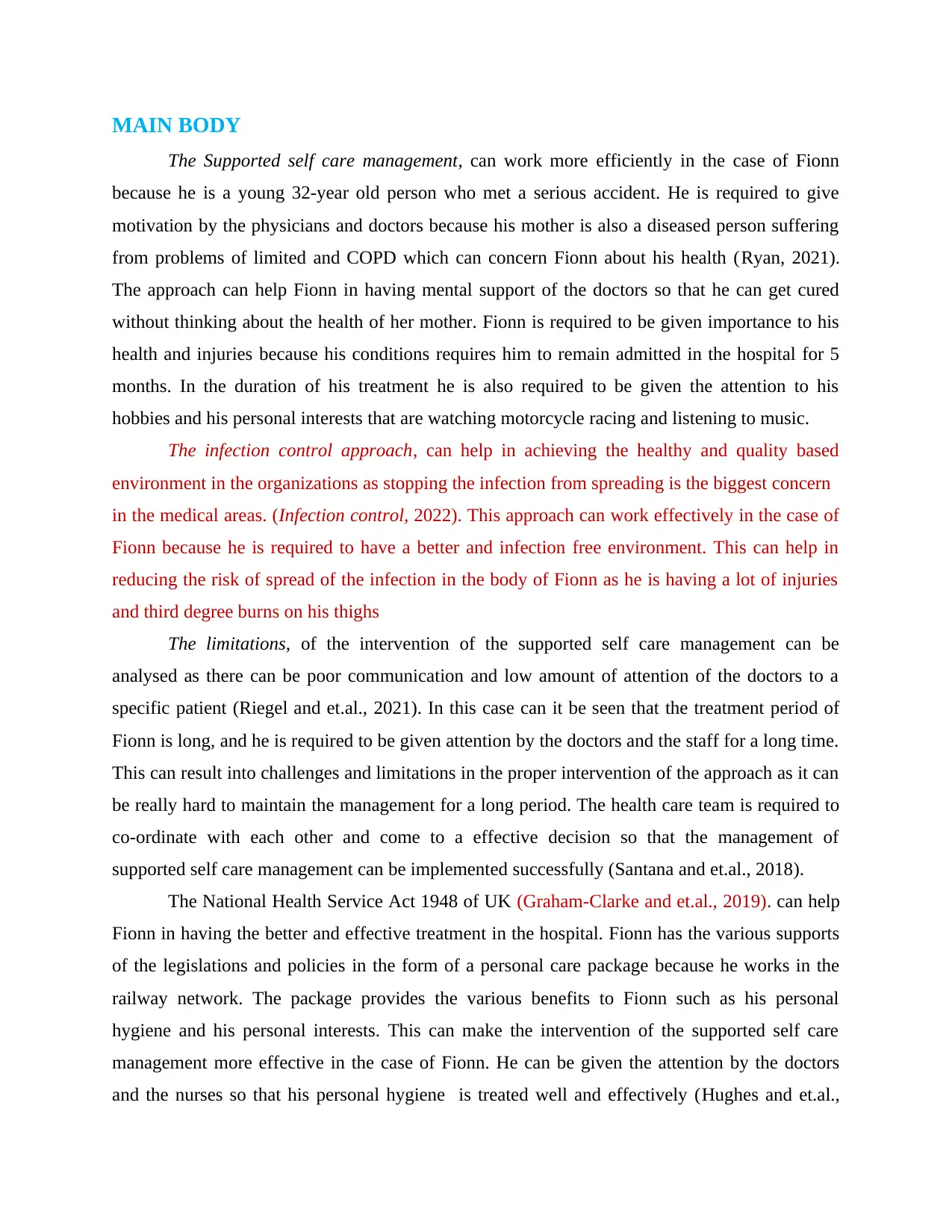
MAIN BODY
The Supported self care management, can work more efficiently in the case of Fionn
because he is a young 32-year old person who met a serious accident. He is required to give
motivation by the physicians and doctors because his mother is also a diseased person suffering
from problems of limited and COPD which can concern Fionn about his health (Ryan, 2021).
The approach can help Fionn in having mental support of the doctors so that he can get cured
without thinking about the health of her mother. Fionn is required to be given importance to his
health and injuries because his conditions requires him to remain admitted in the hospital for 5
months. In the duration of his treatment he is also required to be given the attention to his
hobbies and his personal interests that are watching motorcycle racing and listening to music.
The infection control approach, can help in achieving the healthy and quality based
environment in the organizations as stopping the infection from spreading is the biggest concern
in the medical areas. (Infection control, 2022). This approach can work effectively in the case of
Fionn because he is required to have a better and infection free environment. This can help in
reducing the risk of spread of the infection in the body of Fionn as he is having a lot of injuries
and third degree burns on his thighs
The limitations, of the intervention of the supported self care management can be
analysed as there can be poor communication and low amount of attention of the doctors to a
specific patient (Riegel and et.al., 2021). In this case can it be seen that the treatment period of
Fionn is long, and he is required to be given attention by the doctors and the staff for a long time.
This can result into challenges and limitations in the proper intervention of the approach as it can
be really hard to maintain the management for a long period. The health care team is required to
co-ordinate with each other and come to a effective decision so that the management of
supported self care management can be implemented successfully (Santana and et.al., 2018).
The National Health Service Act 1948 of UK (Graham-Clarke and et.al., 2019). can help
Fionn in having the better and effective treatment in the hospital. Fionn has the various supports
of the legislations and policies in the form of a personal care package because he works in the
railway network. The package provides the various benefits to Fionn such as his personal
hygiene and his personal interests. This can make the intervention of the supported self care
management more effective in the case of Fionn. He can be given the attention by the doctors
and the nurses so that his personal hygiene is treated well and effectively (Hughes and et.al.,
The Supported self care management, can work more efficiently in the case of Fionn
because he is a young 32-year old person who met a serious accident. He is required to give
motivation by the physicians and doctors because his mother is also a diseased person suffering
from problems of limited and COPD which can concern Fionn about his health (Ryan, 2021).
The approach can help Fionn in having mental support of the doctors so that he can get cured
without thinking about the health of her mother. Fionn is required to be given importance to his
health and injuries because his conditions requires him to remain admitted in the hospital for 5
months. In the duration of his treatment he is also required to be given the attention to his
hobbies and his personal interests that are watching motorcycle racing and listening to music.
The infection control approach, can help in achieving the healthy and quality based
environment in the organizations as stopping the infection from spreading is the biggest concern
in the medical areas. (Infection control, 2022). This approach can work effectively in the case of
Fionn because he is required to have a better and infection free environment. This can help in
reducing the risk of spread of the infection in the body of Fionn as he is having a lot of injuries
and third degree burns on his thighs
The limitations, of the intervention of the supported self care management can be
analysed as there can be poor communication and low amount of attention of the doctors to a
specific patient (Riegel and et.al., 2021). In this case can it be seen that the treatment period of
Fionn is long, and he is required to be given attention by the doctors and the staff for a long time.
This can result into challenges and limitations in the proper intervention of the approach as it can
be really hard to maintain the management for a long period. The health care team is required to
co-ordinate with each other and come to a effective decision so that the management of
supported self care management can be implemented successfully (Santana and et.al., 2018).
The National Health Service Act 1948 of UK (Graham-Clarke and et.al., 2019). can help
Fionn in having the better and effective treatment in the hospital. Fionn has the various supports
of the legislations and policies in the form of a personal care package because he works in the
railway network. The package provides the various benefits to Fionn such as his personal
hygiene and his personal interests. This can make the intervention of the supported self care
management more effective in the case of Fionn. He can be given the attention by the doctors
and the nurses so that his personal hygiene is treated well and effectively (Hughes and et.al.,
Paraphrase This Document
Need a fresh take? Get an instant paraphrase of this document with our AI Paraphraser
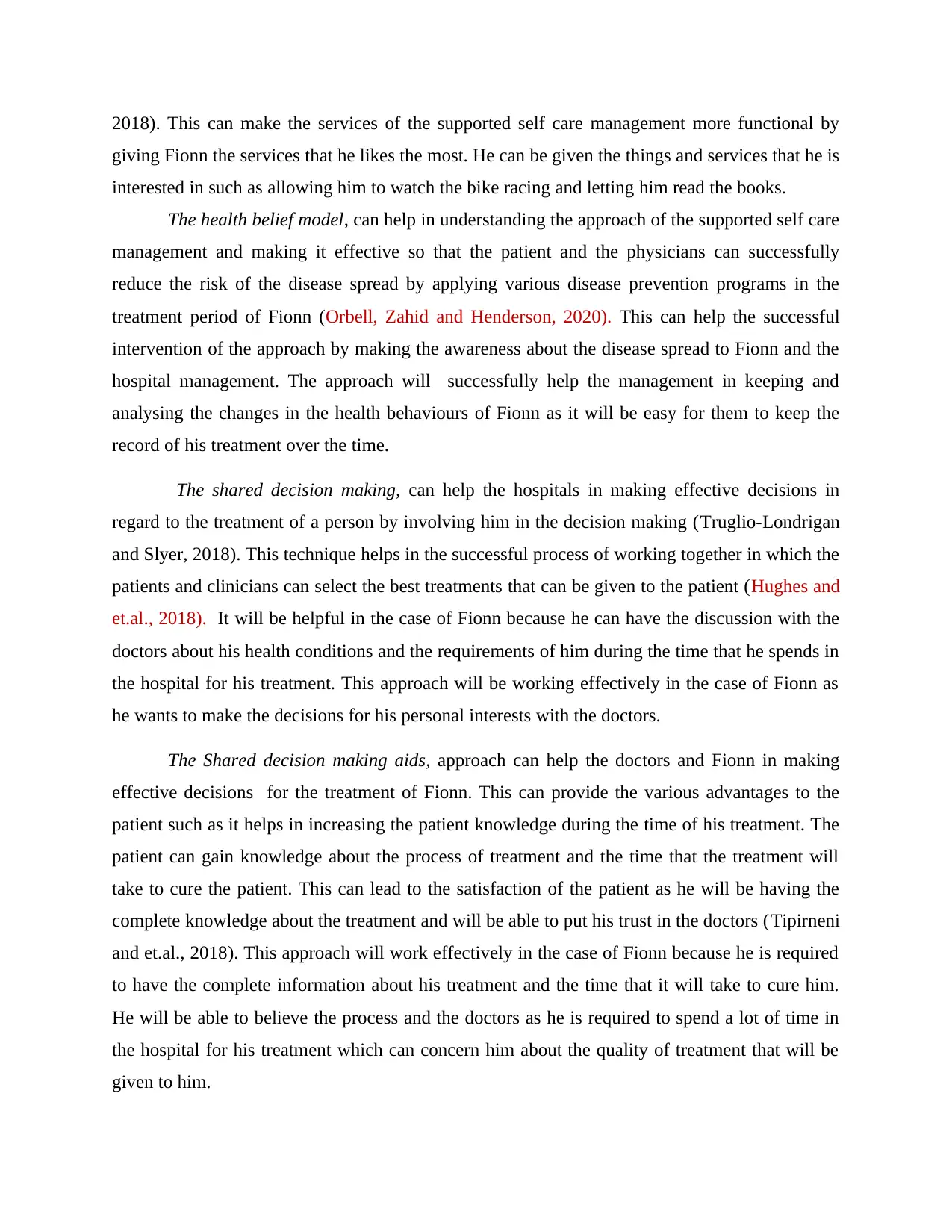
2018). This can make the services of the supported self care management more functional by
giving Fionn the services that he likes the most. He can be given the things and services that he is
interested in such as allowing him to watch the bike racing and letting him read the books.
The health belief model, can help in understanding the approach of the supported self care
management and making it effective so that the patient and the physicians can successfully
reduce the risk of the disease spread by applying various disease prevention programs in the
treatment period of Fionn (Orbell, Zahid and Henderson, 2020). This can help the successful
intervention of the approach by making the awareness about the disease spread to Fionn and the
hospital management. The approach will successfully help the management in keeping and
analysing the changes in the health behaviours of Fionn as it will be easy for them to keep the
record of his treatment over the time.
The shared decision making, can help the hospitals in making effective decisions in
regard to the treatment of a person by involving him in the decision making (Truglio-Londrigan
and Slyer, 2018). This technique helps in the successful process of working together in which the
patients and clinicians can select the best treatments that can be given to the patient (Hughes and
et.al., 2018). It will be helpful in the case of Fionn because he can have the discussion with the
doctors about his health conditions and the requirements of him during the time that he spends in
the hospital for his treatment. This approach will be working effectively in the case of Fionn as
he wants to make the decisions for his personal interests with the doctors.
The Shared decision making aids, approach can help the doctors and Fionn in making
effective decisions for the treatment of Fionn. This can provide the various advantages to the
patient such as it helps in increasing the patient knowledge during the time of his treatment. The
patient can gain knowledge about the process of treatment and the time that the treatment will
take to cure the patient. This can lead to the satisfaction of the patient as he will be having the
complete knowledge about the treatment and will be able to put his trust in the doctors (Tipirneni
and et.al., 2018). This approach will work effectively in the case of Fionn because he is required
to have the complete information about his treatment and the time that it will take to cure him.
He will be able to believe the process and the doctors as he is required to spend a lot of time in
the hospital for his treatment which can concern him about the quality of treatment that will be
given to him.
giving Fionn the services that he likes the most. He can be given the things and services that he is
interested in such as allowing him to watch the bike racing and letting him read the books.
The health belief model, can help in understanding the approach of the supported self care
management and making it effective so that the patient and the physicians can successfully
reduce the risk of the disease spread by applying various disease prevention programs in the
treatment period of Fionn (Orbell, Zahid and Henderson, 2020). This can help the successful
intervention of the approach by making the awareness about the disease spread to Fionn and the
hospital management. The approach will successfully help the management in keeping and
analysing the changes in the health behaviours of Fionn as it will be easy for them to keep the
record of his treatment over the time.
The shared decision making, can help the hospitals in making effective decisions in
regard to the treatment of a person by involving him in the decision making (Truglio-Londrigan
and Slyer, 2018). This technique helps in the successful process of working together in which the
patients and clinicians can select the best treatments that can be given to the patient (Hughes and
et.al., 2018). It will be helpful in the case of Fionn because he can have the discussion with the
doctors about his health conditions and the requirements of him during the time that he spends in
the hospital for his treatment. This approach will be working effectively in the case of Fionn as
he wants to make the decisions for his personal interests with the doctors.
The Shared decision making aids, approach can help the doctors and Fionn in making
effective decisions for the treatment of Fionn. This can provide the various advantages to the
patient such as it helps in increasing the patient knowledge during the time of his treatment. The
patient can gain knowledge about the process of treatment and the time that the treatment will
take to cure the patient. This can lead to the satisfaction of the patient as he will be having the
complete knowledge about the treatment and will be able to put his trust in the doctors (Tipirneni
and et.al., 2018). This approach will work effectively in the case of Fionn because he is required
to have the complete information about his treatment and the time that it will take to cure him.
He will be able to believe the process and the doctors as he is required to spend a lot of time in
the hospital for his treatment which can concern him about the quality of treatment that will be
given to him.
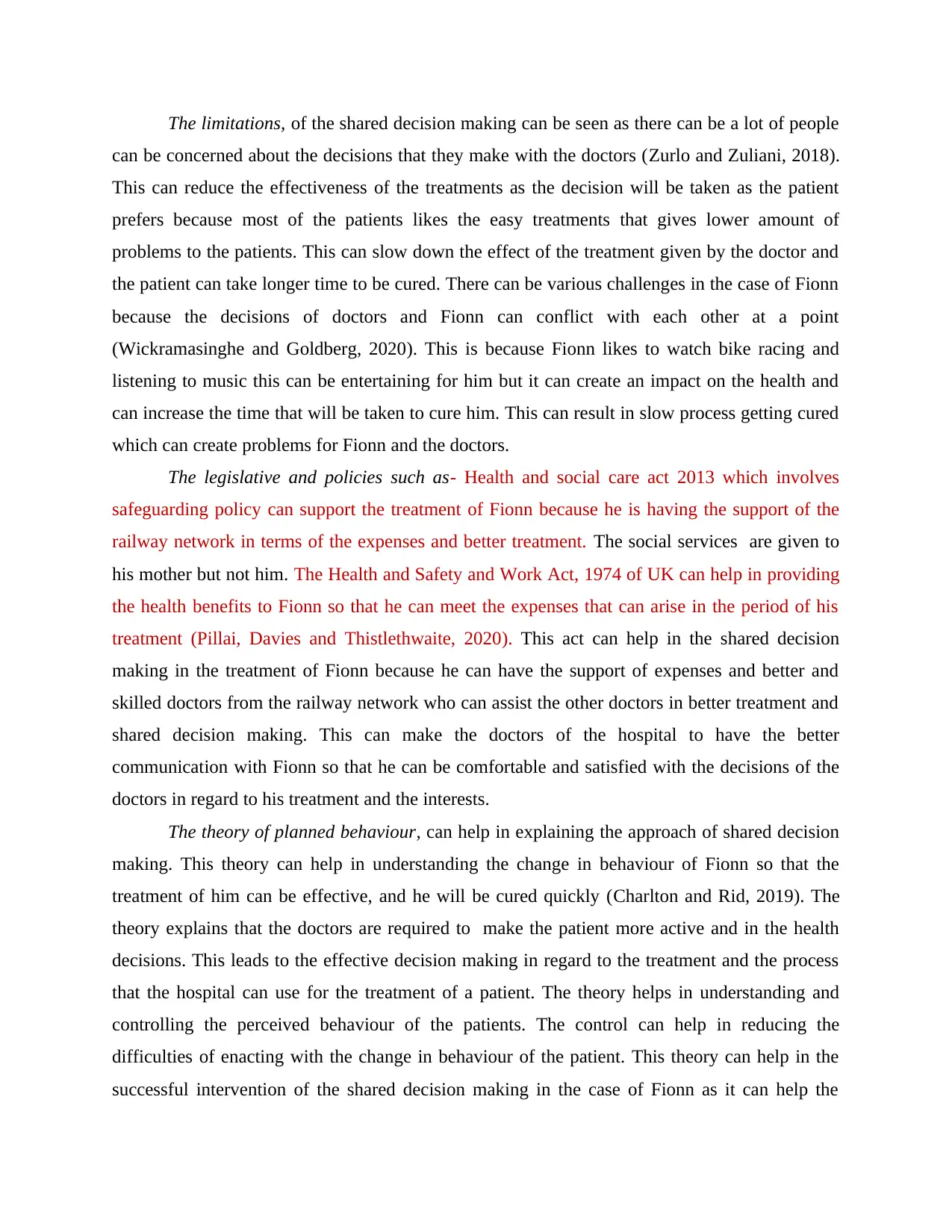
The limitations, of the shared decision making can be seen as there can be a lot of people
can be concerned about the decisions that they make with the doctors (Zurlo and Zuliani, 2018).
This can reduce the effectiveness of the treatments as the decision will be taken as the patient
prefers because most of the patients likes the easy treatments that gives lower amount of
problems to the patients. This can slow down the effect of the treatment given by the doctor and
the patient can take longer time to be cured. There can be various challenges in the case of Fionn
because the decisions of doctors and Fionn can conflict with each other at a point
(Wickramasinghe and Goldberg, 2020). This is because Fionn likes to watch bike racing and
listening to music this can be entertaining for him but it can create an impact on the health and
can increase the time that will be taken to cure him. This can result in slow process getting cured
which can create problems for Fionn and the doctors.
The legislative and policies such as- Health and social care act 2013 which involves
safeguarding policy can support the treatment of Fionn because he is having the support of the
railway network in terms of the expenses and better treatment. The social services are given to
his mother but not him. The Health and Safety and Work Act, 1974 of UK can help in providing
the health benefits to Fionn so that he can meet the expenses that can arise in the period of his
treatment (Pillai, Davies and Thistlethwaite, 2020). This act can help in the shared decision
making in the treatment of Fionn because he can have the support of expenses and better and
skilled doctors from the railway network who can assist the other doctors in better treatment and
shared decision making. This can make the doctors of the hospital to have the better
communication with Fionn so that he can be comfortable and satisfied with the decisions of the
doctors in regard to his treatment and the interests.
The theory of planned behaviour, can help in explaining the approach of shared decision
making. This theory can help in understanding the change in behaviour of Fionn so that the
treatment of him can be effective, and he will be cured quickly (Charlton and Rid, 2019). The
theory explains that the doctors are required to make the patient more active and in the health
decisions. This leads to the effective decision making in regard to the treatment and the process
that the hospital can use for the treatment of a patient. The theory helps in understanding and
controlling the perceived behaviour of the patients. The control can help in reducing the
difficulties of enacting with the change in behaviour of the patient. This theory can help in the
successful intervention of the shared decision making in the case of Fionn as it can help the
can be concerned about the decisions that they make with the doctors (Zurlo and Zuliani, 2018).
This can reduce the effectiveness of the treatments as the decision will be taken as the patient
prefers because most of the patients likes the easy treatments that gives lower amount of
problems to the patients. This can slow down the effect of the treatment given by the doctor and
the patient can take longer time to be cured. There can be various challenges in the case of Fionn
because the decisions of doctors and Fionn can conflict with each other at a point
(Wickramasinghe and Goldberg, 2020). This is because Fionn likes to watch bike racing and
listening to music this can be entertaining for him but it can create an impact on the health and
can increase the time that will be taken to cure him. This can result in slow process getting cured
which can create problems for Fionn and the doctors.
The legislative and policies such as- Health and social care act 2013 which involves
safeguarding policy can support the treatment of Fionn because he is having the support of the
railway network in terms of the expenses and better treatment. The social services are given to
his mother but not him. The Health and Safety and Work Act, 1974 of UK can help in providing
the health benefits to Fionn so that he can meet the expenses that can arise in the period of his
treatment (Pillai, Davies and Thistlethwaite, 2020). This act can help in the shared decision
making in the treatment of Fionn because he can have the support of expenses and better and
skilled doctors from the railway network who can assist the other doctors in better treatment and
shared decision making. This can make the doctors of the hospital to have the better
communication with Fionn so that he can be comfortable and satisfied with the decisions of the
doctors in regard to his treatment and the interests.
The theory of planned behaviour, can help in explaining the approach of shared decision
making. This theory can help in understanding the change in behaviour of Fionn so that the
treatment of him can be effective, and he will be cured quickly (Charlton and Rid, 2019). The
theory explains that the doctors are required to make the patient more active and in the health
decisions. This leads to the effective decision making in regard to the treatment and the process
that the hospital can use for the treatment of a patient. The theory helps in understanding and
controlling the perceived behaviour of the patients. The control can help in reducing the
difficulties of enacting with the change in behaviour of the patient. This theory can help in the
successful intervention of the shared decision making in the case of Fionn as it can help the
⊘ This is a preview!⊘
Do you want full access?
Subscribe today to unlock all pages.

Trusted by 1+ million students worldwide
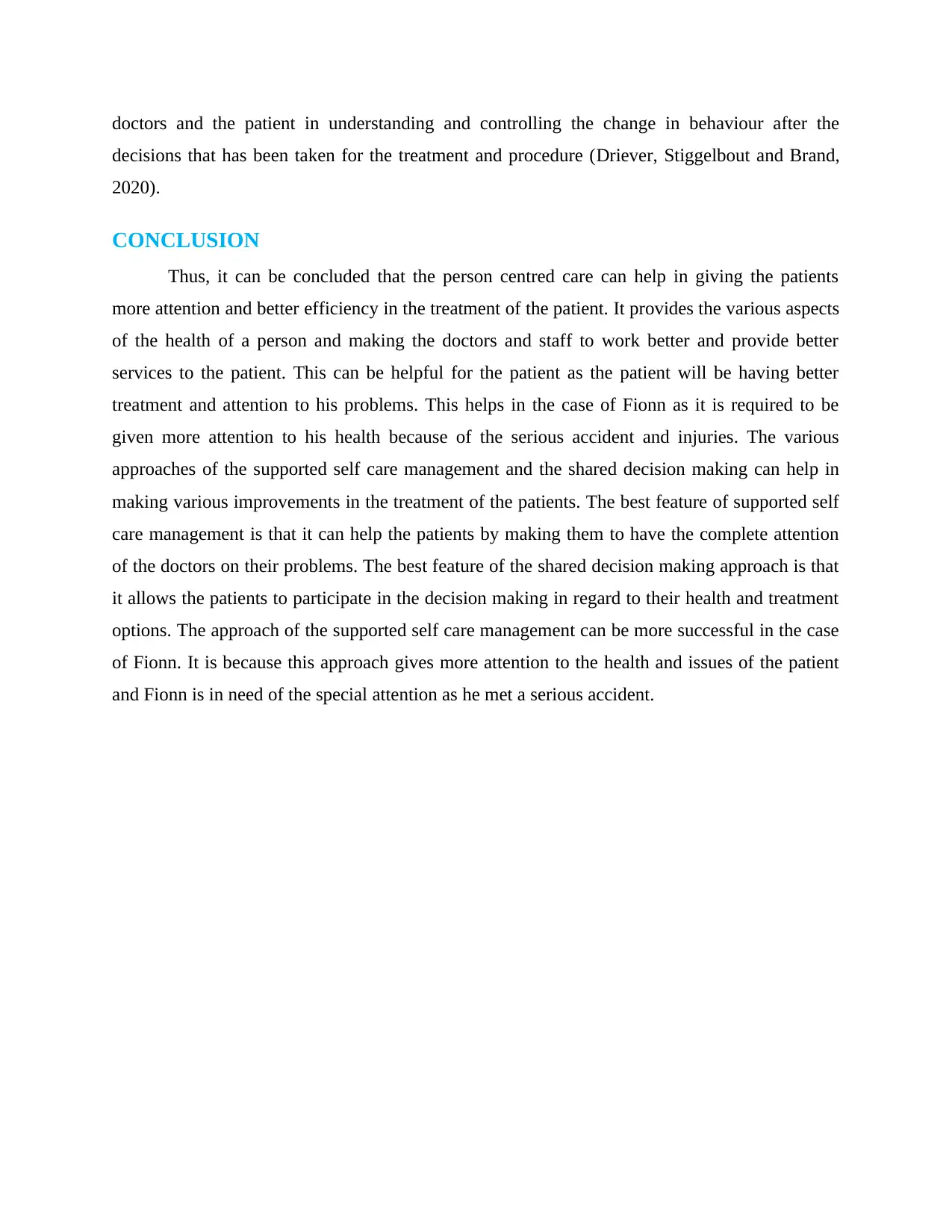
doctors and the patient in understanding and controlling the change in behaviour after the
decisions that has been taken for the treatment and procedure (Driever, Stiggelbout and Brand,
2020).
CONCLUSION
Thus, it can be concluded that the person centred care can help in giving the patients
more attention and better efficiency in the treatment of the patient. It provides the various aspects
of the health of a person and making the doctors and staff to work better and provide better
services to the patient. This can be helpful for the patient as the patient will be having better
treatment and attention to his problems. This helps in the case of Fionn as it is required to be
given more attention to his health because of the serious accident and injuries. The various
approaches of the supported self care management and the shared decision making can help in
making various improvements in the treatment of the patients. The best feature of supported self
care management is that it can help the patients by making them to have the complete attention
of the doctors on their problems. The best feature of the shared decision making approach is that
it allows the patients to participate in the decision making in regard to their health and treatment
options. The approach of the supported self care management can be more successful in the case
of Fionn. It is because this approach gives more attention to the health and issues of the patient
and Fionn is in need of the special attention as he met a serious accident.
decisions that has been taken for the treatment and procedure (Driever, Stiggelbout and Brand,
2020).
CONCLUSION
Thus, it can be concluded that the person centred care can help in giving the patients
more attention and better efficiency in the treatment of the patient. It provides the various aspects
of the health of a person and making the doctors and staff to work better and provide better
services to the patient. This can be helpful for the patient as the patient will be having better
treatment and attention to his problems. This helps in the case of Fionn as it is required to be
given more attention to his health because of the serious accident and injuries. The various
approaches of the supported self care management and the shared decision making can help in
making various improvements in the treatment of the patients. The best feature of supported self
care management is that it can help the patients by making them to have the complete attention
of the doctors on their problems. The best feature of the shared decision making approach is that
it allows the patients to participate in the decision making in regard to their health and treatment
options. The approach of the supported self care management can be more successful in the case
of Fionn. It is because this approach gives more attention to the health and issues of the patient
and Fionn is in need of the special attention as he met a serious accident.
Paraphrase This Document
Need a fresh take? Get an instant paraphrase of this document with our AI Paraphraser
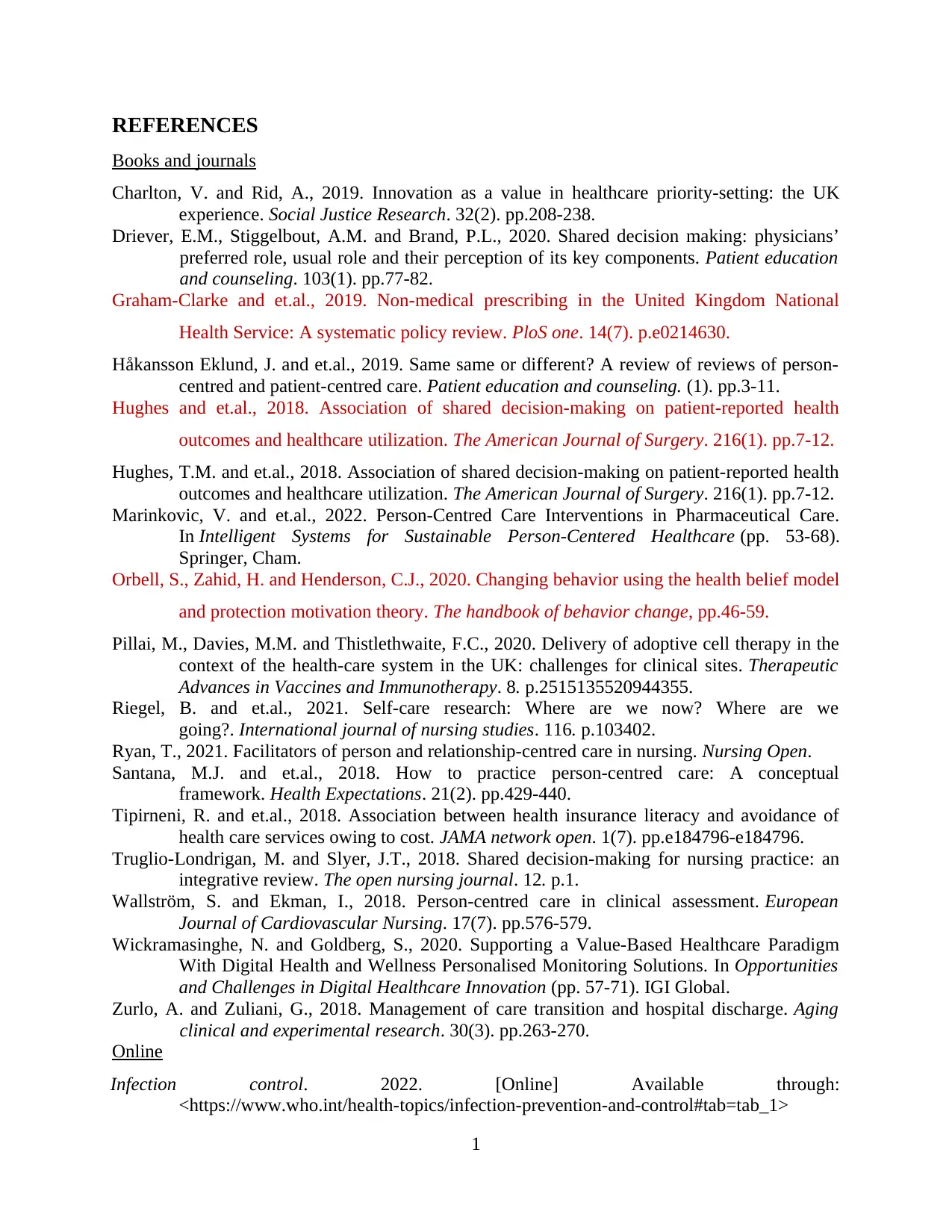
REFERENCES
Books and journals
Charlton, V. and Rid, A., 2019. Innovation as a value in healthcare priority-setting: the UK
experience. Social Justice Research. 32(2). pp.208-238.
Driever, E.M., Stiggelbout, A.M. and Brand, P.L., 2020. Shared decision making: physicians’
preferred role, usual role and their perception of its key components. Patient education
and counseling. 103(1). pp.77-82.
Graham-Clarke and et.al., 2019. Non-medical prescribing in the United Kingdom National
Health Service: A systematic policy review. PloS one. 14(7). p.e0214630.
Håkansson Eklund, J. and et.al., 2019. Same same or different? A review of reviews of person-
centred and patient-centred care. Patient education and counseling. (1). pp.3-11.
Hughes and et.al., 2018. Association of shared decision-making on patient-reported health
outcomes and healthcare utilization. The American Journal of Surgery. 216(1). pp.7-12.
Hughes, T.M. and et.al., 2018. Association of shared decision-making on patient-reported health
outcomes and healthcare utilization. The American Journal of Surgery. 216(1). pp.7-12.
Marinkovic, V. and et.al., 2022. Person-Centred Care Interventions in Pharmaceutical Care.
In Intelligent Systems for Sustainable Person-Centered Healthcare (pp. 53-68).
Springer, Cham.
Orbell, S., Zahid, H. and Henderson, C.J., 2020. Changing behavior using the health belief model
and protection motivation theory. The handbook of behavior change, pp.46-59.
Pillai, M., Davies, M.M. and Thistlethwaite, F.C., 2020. Delivery of adoptive cell therapy in the
context of the health-care system in the UK: challenges for clinical sites. Therapeutic
Advances in Vaccines and Immunotherapy. 8. p.2515135520944355.
Riegel, B. and et.al., 2021. Self-care research: Where are we now? Where are we
going?. International journal of nursing studies. 116. p.103402.
Ryan, T., 2021. Facilitators of person and relationship‐centred care in nursing. Nursing Open.
Santana, M.J. and et.al., 2018. How to practice person‐centred care: A conceptual
framework. Health Expectations. 21(2). pp.429-440.
Tipirneni, R. and et.al., 2018. Association between health insurance literacy and avoidance of
health care services owing to cost. JAMA network open. 1(7). pp.e184796-e184796.
Truglio-Londrigan, M. and Slyer, J.T., 2018. Shared decision-making for nursing practice: an
integrative review. The open nursing journal. 12. p.1.
Wallström, S. and Ekman, I., 2018. Person-centred care in clinical assessment. European
Journal of Cardiovascular Nursing. 17(7). pp.576-579.
Wickramasinghe, N. and Goldberg, S., 2020. Supporting a Value-Based Healthcare Paradigm
With Digital Health and Wellness Personalised Monitoring Solutions. In Opportunities
and Challenges in Digital Healthcare Innovation (pp. 57-71). IGI Global.
Zurlo, A. and Zuliani, G., 2018. Management of care transition and hospital discharge. Aging
clinical and experimental research. 30(3). pp.263-270.
Online
Infection control. 2022. [Online] Available through:
<https://www.who.int/health-topics/infection-prevention-and-control#tab=tab_1>
1
Books and journals
Charlton, V. and Rid, A., 2019. Innovation as a value in healthcare priority-setting: the UK
experience. Social Justice Research. 32(2). pp.208-238.
Driever, E.M., Stiggelbout, A.M. and Brand, P.L., 2020. Shared decision making: physicians’
preferred role, usual role and their perception of its key components. Patient education
and counseling. 103(1). pp.77-82.
Graham-Clarke and et.al., 2019. Non-medical prescribing in the United Kingdom National
Health Service: A systematic policy review. PloS one. 14(7). p.e0214630.
Håkansson Eklund, J. and et.al., 2019. Same same or different? A review of reviews of person-
centred and patient-centred care. Patient education and counseling. (1). pp.3-11.
Hughes and et.al., 2018. Association of shared decision-making on patient-reported health
outcomes and healthcare utilization. The American Journal of Surgery. 216(1). pp.7-12.
Hughes, T.M. and et.al., 2018. Association of shared decision-making on patient-reported health
outcomes and healthcare utilization. The American Journal of Surgery. 216(1). pp.7-12.
Marinkovic, V. and et.al., 2022. Person-Centred Care Interventions in Pharmaceutical Care.
In Intelligent Systems for Sustainable Person-Centered Healthcare (pp. 53-68).
Springer, Cham.
Orbell, S., Zahid, H. and Henderson, C.J., 2020. Changing behavior using the health belief model
and protection motivation theory. The handbook of behavior change, pp.46-59.
Pillai, M., Davies, M.M. and Thistlethwaite, F.C., 2020. Delivery of adoptive cell therapy in the
context of the health-care system in the UK: challenges for clinical sites. Therapeutic
Advances in Vaccines and Immunotherapy. 8. p.2515135520944355.
Riegel, B. and et.al., 2021. Self-care research: Where are we now? Where are we
going?. International journal of nursing studies. 116. p.103402.
Ryan, T., 2021. Facilitators of person and relationship‐centred care in nursing. Nursing Open.
Santana, M.J. and et.al., 2018. How to practice person‐centred care: A conceptual
framework. Health Expectations. 21(2). pp.429-440.
Tipirneni, R. and et.al., 2018. Association between health insurance literacy and avoidance of
health care services owing to cost. JAMA network open. 1(7). pp.e184796-e184796.
Truglio-Londrigan, M. and Slyer, J.T., 2018. Shared decision-making for nursing practice: an
integrative review. The open nursing journal. 12. p.1.
Wallström, S. and Ekman, I., 2018. Person-centred care in clinical assessment. European
Journal of Cardiovascular Nursing. 17(7). pp.576-579.
Wickramasinghe, N. and Goldberg, S., 2020. Supporting a Value-Based Healthcare Paradigm
With Digital Health and Wellness Personalised Monitoring Solutions. In Opportunities
and Challenges in Digital Healthcare Innovation (pp. 57-71). IGI Global.
Zurlo, A. and Zuliani, G., 2018. Management of care transition and hospital discharge. Aging
clinical and experimental research. 30(3). pp.263-270.
Online
Infection control. 2022. [Online] Available through:
<https://www.who.int/health-topics/infection-prevention-and-control#tab=tab_1>
1

2
⊘ This is a preview!⊘
Do you want full access?
Subscribe today to unlock all pages.

Trusted by 1+ million students worldwide
1 out of 9
Related Documents
Your All-in-One AI-Powered Toolkit for Academic Success.
+13062052269
info@desklib.com
Available 24*7 on WhatsApp / Email
![[object Object]](/_next/static/media/star-bottom.7253800d.svg)
Unlock your academic potential
Copyright © 2020–2025 A2Z Services. All Rights Reserved. Developed and managed by ZUCOL.



